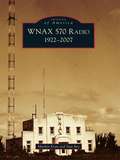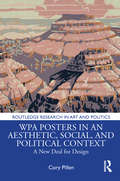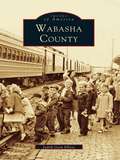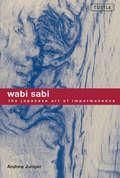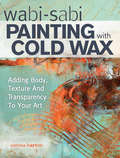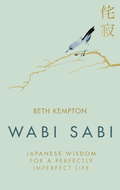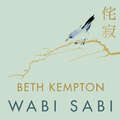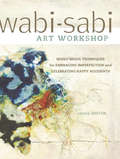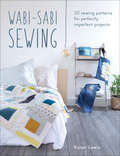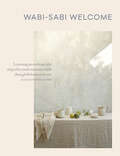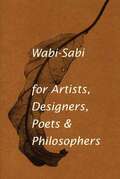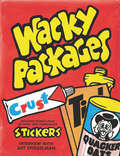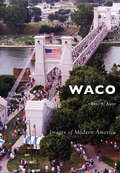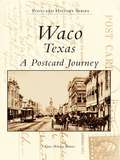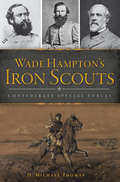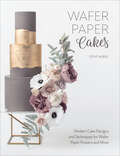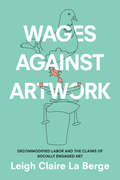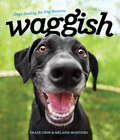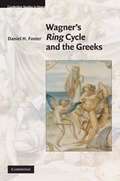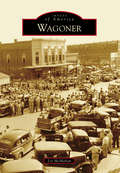- Table View
- List View
WNAX 570 Radio: 1922-2007
by Stan Ray Marilyn KratzLife on the northern plains was lonely in the early 20th century. Farmers and ranchers went for weeks without hearing any voices other than those of their families. Then, in 1922, Al Madson, proprietor of a Yankton radio parts shop, made a radio transmitter. He formed a broadcasting company, and on November 25, 1922, WNAX broadcast its first program. People of the northern plains now had a daily "visitor." Gurney Seed and Nursery Company owned the station for its first 16 years, adding distinctive innovations to its programming. In its constant commitment to agriculture, the station has influenced the history of the five-state area it covers. Lawrence Welk got his start there. Wynn Speece, known as the Neighbor Lady, still broadcasts daily after starting at WNAX in 1941.
WPA Posters in an Aesthetic, Social, and Political Context: A New Deal for Design (Routledge Research in Art and Politics)
by Cory PillenThis book examines posters produced by the Works Progress Administration (WPA), a federal relief program designed to create jobs in the United States during the Great Depression. Cory Pillen focuses on several issues addressed repeatedly in the roughly 2,200 extant WPA posters created between 1935 and 1943: recreation and leisure, conservation, health and disease, and public housing. As the book shows, the posters promote specific forms of knowledge and literacy as solutions to contemporary social concerns. The varied issues these works engage and the ideals they endorse, however, would have resonated in complex ways with the posters’ diverse viewing public, working both for and against the rhetoric of consensus employed by New Deal agencies in defining and managing the relationship between self and society in modern America. This book will be of interest to scholars in design history, art history, and American studies.
WTF, Evolution?!: A Theory of Unintelligible Design
by Mara GrunbaumWe all have our off days. Why should Evolution be any different? Maybe Evolution got carried away with an idea that was just a little too crazy—like having the Regal Horned Lizard defend itself by shooting three-foot streams of blood from its eyes. Or maybe Evolution ran out of steam (Memo to Evolution: The Irrawaddy Dolphin looks like a prototype that should have been left on the drawing board). Or maybe Evolution was feeling cheeky—a fish with hands? Joke’s on you, Red Handfish! Or maybe Evolution simply goofed up: How else to explain the overgrown teeth of the babirusas that curl backward over their face? Oops. Mara Grunbaum is a very smart, very funny science writer who celebrates the best—or, really, the worst—of Evolution’s blunders. Here are more than 100 outlandish mammals, reptiles, insects, fish, birds, and other creatures whose very existence leaves us shaking our heads and muttering WTF?! Ms. Grunbaum’s especially brilliant stroke is to personify Evolution as a well-meaning but somewhat oblivious experimenter whose conversations with a skeptical narrator are hilarious. For almost 4 billion years, Evolution has produced a nonstop parade of inflatable noses, bizarre genitalia, and seriously awkward necks. What a comedian!
WYXIE Wonderland: An Unauthorized 50-Year Diary of WXYZ Detroit
by Dick OsgoodWYXIE WONDERLAND, by Dick Osgood, is a good time and more than that. Here is possibly the first comprehensive exploration into the inner workings of a broadcasting enterprise. It is as broad as it is deep, revealing the secrets of top management as completely as--perhaps even more fully than--it does the vagaries of performing talent. It is not a purely local story. Fifty years of national radio and television history--1925-1975--are reflected in the fundamental and accidental specifics of a single station--WXYZ, Detroit-AM, FM and TV. This is the diary of that station, unauthorized and independently written. WYXIE WONDERLAND was much more than the birthplace of The Lone Ranger, The Green Hornet and Sergeant Preston of the Yukon. It was the starting point of SOUPY SALES and MIKE WALLACE, of DOUGLAS EDWARDS and JOHN HODIAK, of GEORGE SEATON, MARTHA SCOTT and DANNY THOMAS. Here are the hilarious fluffs, minor on-the-air disasters and a phantom broadcast. This extraordinary book traces the beginnings of five networks; it follows the rise and decline of radio network programming. It sees the radio actor replaced by--the disc jockey. There are record hops with FABIAN, CHUCK BERRY and STEVIE WONDER. WYXIE WONDERLAND explains how the scandal of radio payola grew out of the discovery of rigged TV quiz programs. It tells of a sound created in Texas that revolutionized radio, and how the Top 40 format emerged from a bar in Omaha. The confusion of early television is in it as well as of early radio, and the nefarious underground beginnings of FM. Alcoholism is discovered to be something of an occupational disease. The infighting among stations and executives for ratings, accounts and position gets tough. Personalities clash. There are victories and surprising defeats.
Wabasha County
by Judith Giem ElliotWabasha County captures the spirit of a region and its people through rare historic photographs, many of which are previously unpublished. A truly multicultural community, Wabasha County has been home to residents of Canadian, French, English, Irish, Native American, and German origin. The earliest known pioneers, Augustine Rocque and his family, became the first white people to occupy a year-round residence in Minnesota in 1826. Within these pages, discover the people and events that have shaped Wabasha County's history over the past 170 years. Wabasha County was named after the great chief Wabashaw II. Many aspects of Wabasha's heritage are featured here, including the dewakanton Band of the Dakotas, riverboats of the Mississippi, pioneers and their descendants, and buildings throughout the area. Author Judith Giem Elliott has produced a volume that truly reflects the value Wabasha County's residents place upon their rich and colorful history.
Wabi Sabi
by Andrew JuniperWabi sabi, the quintessential Japanese design aesthetic, is quickly gaining popularity around the world, as evidenced by recent articles in Time, The Chicago Tribune and Kyoto Journal. Taken from the Japanese words wabi, which translates to less is more, and sabi, which means attentive melancholy, wabi sabi refers to an awareness of the transient nature of earthly things and a corresponding pleasure in the things that bear the mark of this impermanence. As a design style, wabi sabi helps us to appreciate the simple beauty in imperfection--of a chipped vase or a rainy day, for example.
Wabi Sabi
by Andrew JuniperWabi sabi, the quintessential Japanese design aesthetic, is quickly gaining popularity around the world, as evidenced by recent articles in Time, The Chicago Tribune and Kyoto Journal. Taken from the Japanese words wabi, which translates to less is more, and sabi, which means attentive melancholy, wabi sabi refers to an awareness of the transient nature of earthly things and a corresponding pleasure in the things that bear the mark of this impermanence. As a design style, wabi sabi helps us to appreciate the simple beauty in imperfection--of a chipped vase or a rainy day, for example.
Wabi Sabi
by Andrew JuniperDeveloped out of the aesthetic philosophy of cha-no-yu (the tea ceremony) in fifteenth-century Japan, wabi sabi is an aesthetic that finds beauty in things imperfect, impermanent, and incomplete. Taken from the Japanese words wabi, which translates to less is more, and sabi, which means attentive melancholy, wabi sabi refers to an awareness of the transient nature of earthly things and a corresponding pleasure in the things that bear the mark of this impermanence. As much a state of mind--an awareness of the things around us and an acceptance of our surroundings--as it is a design style, wabi sabi begs us to appreciate the simple beauty in life--a chipped vase, a quiet rainy day, the impermanence of all things. Presenting itself as an alternative to today's fast-paced, mass-produced, neon-lighted world, wabi sabi reminds us to slow down and take comfort in the simple, natural beauty around us.In addition to presenting the philosophy of wabi-sabi, this book includes how-to design advice--so that a transformation of body, mind, and home can emerge.Chapters include:History: The Development of Wabi SabiCulture: Wabi Sabi and the Japanese CharacterArt: Defining AestheticsDesign: Creating Expressions with Wabi Sabi MaterialsSpirit: The Universal Spirit of Wabi Sabi
Wabi Sabi Painting with Cold Wax: Adding Body, Texture and Transparency to Your Art
by Serena BartonThe ancient philosophy of wabi-sabi honors the imperfect, the transitory and the humble. Cold wax is a perfect vehicle for artists wishing to explore this aesthetic. In this guide, you'll learn how to use this incredibly malleable medium--in combination with oil paint and other mediums--to add layers of texture, atmosphere, depth and meaning to your paintings while developing a more intuitive artistic voice.No matter what your experience level, learning to paint with cold wax will help you approach your work with confidence and a sense of adventure. You will learn a liberating process of texturing, layering, building up and scraping back to create a fascinating "history of surface." Each piece will be the result of elements converging in a one-time-only way, resulting in fiercely original abstract paintings honoring your own process of self discovery.Learn Everything You Need to Know to Create With Cold Wax!29 step-by-step demonstrations cover various techniques for working with oil paint and cold wax medium.Explore dozens of mark-making techniques with a variety of tools, most of which can be found in your kitchen or junk drawer.Excavate using various approaches for incising, exposing and scraping away layers.Get inspired as 12 additional artists share their creative processes. Embrace unexpected turns, discover the beauty in simplicity and lose yourself in the process as you join Serena Barton on this creative and spiritual journey.
Wabi Sabi: Japanese Wisdom for a Perfectly Imperfect Life
by Beth Kempton'A truly transformative read' Sunday Times STYLE'More than ever, we need books like this' Jessica Seaton, Co-Founder of Toast and author of Gather, Cook, FeastA whole new way of looking at the world - and your life - inspired by centuries-old Japanese wisdom.Wabi sabi ("wah-bi sah-bi") is a captivating concept from Japanese aesthetics, which helps us to see beauty in imperfection, appreciate simplicity and accept the transient nature of all things. With roots in zen and the way of tea, the timeless wisdom of wabi sabi is more relevant than ever for modern life, as we search for new ways to approach life's challenges and seek meaning beyond materialism.Wabi sabi is a refreshing antidote to our fast-paced, consumption-driven world, which will encourage you to slow down, reconnect with nature, and be gentler on yourself. It will help you simplify everything, and concentrate on what really matters.From honouring the rhythm of the seasons to creating a welcoming home, from reframing failure to ageing with grace, wabi sabi will teach you to find more joy and inspiration throughout your perfectly imperfect life.This book is the definitive guide to applying the principles of wabi sabi to transform every area of your life, and finding happiness right where you are.
Wabi Sabi: Japanese Wisdom for a Perfectly Imperfect Life
by Beth Kempton'A truly transformative read' Sunday Times STYLE'More than ever, we need books like this' Jessica Seaton, Co-Founder of Toast and author of Gather, Cook, FeastA whole new way of looking at the world - and your life - inspired by centuries-old Japanese wisdom.Wabi sabi ("wah-bi sah-bi") is a captivating concept from Japanese aesthetics, which helps us to see beauty in imperfection, appreciate simplicity and accept the transient nature of all things. With roots in zen and the way of tea, the timeless wisdom of wabi sabi is more relevant than ever for modern life, as we search for new ways to approach life's challenges and seek meaning beyond materialism.Wabi sabi is a refreshing antidote to our fast-paced, consumption-driven world, which will encourage you to slow down, reconnect with nature, and be gentler on yourself. It will help you simplify everything, and concentrate on what really matters.From honouring the rhythm of the seasons to creating a welcoming home, from reframing failure to ageing with grace, wabi sabi will teach you to find more joy and inspiration throughout your perfectly imperfect life.This book is the definitive guide to applying the principles of wabi sabi to transform every area of your life, and finding happiness right where you are.
Wabi-Sabi Art Workshop: Art Workshop
by Serena BartonAre you inspired by the little things, the bits others might overlook? A crack in the sidewalk? The trunk of a fallen tree? Shards of broken pottery? Do you want your artwork to speak to the abstract nature of color, and shape and texture, composition and mood? With Wabi-Sabi Art Workshop, you'll learn to use your appreciation for the simple things in life--the ordinary, the aged, the humble--as your inspiration for making expressive, intuitive art. You will come to embrace imperfection and recognize that, yes, in fact, there is such a thing as a happy accident! The wabi-sabi philosophy of art is probably a little different from what you're used to--it's a style that finds inspiration and beauty in the imperfect, impermanent and humble nature of everyday objects. And there is a special freedom in wabi-sabi's abstract aesthetic, a forgiving approach that celebrates so-called mistakes and fosters an experimental spirit, encouraging you to build up and tear back with abandon. Inside Wabi-Sabi Art Workshop You'll Find: Dozens of inspiration photos and tips for taking your own. 27 traditional haikus. 35 techniques using such diverse media as oil and acrylic paints, alcohol inkers, foils and leaf, pastels, plaster, collage and handmade papers, teabags, paper towels, coffee, crayons, encaustic paints, fibers and more. Lots of Wabi-Sabi Wisdom--tips and troubleshooting. 70 big, beautiful finished pieces of art illustrating featured techniques. Links to online bonus content--step-by-step demonstrations illustrating six additional techniques. Add Wabi-Sabi Art Workshop to your artistic library and expand your artistic horizons today!
Wabi-Sabi Sewing: 20 Sewing Patterns for Perfectly Imperfect Projects
by Karen LewisCapture the essence of Japanese style in your sewing with this collection of projects inspired by the wabi-sabi concept of 'perfect imperfection'. This collection of 20 sewing projects for home decor and accessories is based on the popular Japanese aesthetic of wabi-sabi which celebrates the beauty in the ordinary and imperfect. The projects are grouped according to how we live, for example: living; sleeping; eating and exploring. Sewing and quilting expert and fabric designer, Karen Lewis, has used a limited palette of earthy tones and the best quality natural fabrics including linen, cotton, denim and wool to create a stunning collection of simple, sewn projects. Try out some simple wabi-sabi style sewing techniques such as hand hand piecing, sashiko embroidery, big stitch quilting, and visible mending to create unique items for your home whether it's a full sized bed quilt, simple coasters for your favourite mug or a stunning scarf to wrap up in.
Wabi-Sabi Welcome: Learning to Embrace the Imperfect and Entertain with Thoughtfulness and Ease
by Julie Pointer Adams“An antidote to the veneer of perfectionism so often presented by books of its kind, Wabi-Sabi Welcome offers readers license to slow down and host guests with humility, intention, and contentment.” —Nathan Williams, founder of KinfolkWabi-Sabi Welcome is sharing a pot of tea with friends. It is preparing delicious food to nourish, not to show off. It’s keeping a basket of cozy slippers at the door for guests. It is well-worn linens, bouquets of foraged branches, mismatched silverware, and heirloom bowls infused with the spirit of meals served with love. In this lush entertaining manual, author Julie Pointer Adams invites readers into artful, easygoing homes around the world—in Denmark, California, France, Italy, and Japan—and teaches us how to turn the generous act of getting together into the deeper art of being together. In this book, readers will find: unexpected, thoughtful ideas and recipes from around the world; tips for creating an intimate, welcoming environment; guidelines for choosing enduring, natural decor for the home; and inspiring photographs from homes where wabi-sabi is woven into daily living.
Wabi-Sabi for Artists, Designers, Poets & Philosophers
by Leonard KorenEvery book with "wabi" or "wabi sabi" in the title is based on the concepts first elucidated in this book.
Wacky Packages (Topps Ser.)
by The Topps CompanyTake a fun look back at Quacker Oats, Blisterine, and more classic packaging parodies—plus an interview with creator Art Spiegelman! Known affectionately among collectors as &“Wacky Packs,&” the Topps stickers that parodied well-known consumer brands were a phenomenon in the 1970s—even outselling the Topps Company&’s baseball cards for a while. But few know that the genius behind it all was none other than Art Spiegelman—the Pulitzer Prize–winning graphic novelist who created Maus. This treasury includes an interview with Spiegelman about his early career and his decades-long relationship with the memorabilia company—as well as a colorful compendium that will bring back memories of such products as Plastered Peanuts, Jail-O, Weakies cereal, and many more. Illustrated by notable comics artists Kim Deitch, Bill Griffith, Jay Lynch, Norm Saunders, and more, this collection is a visual treat, a load of laughs, and a tribute to a beloved product that&’s been delighting kids (and adults) for decades.
Waco (Images of Modern America)
by Eric AmesThe story of Waco's modern era starts with a disaster and ends with rebirth. In 1953, a record-setting tornado swept through the city's downtown, killing 114 people and destroying a century's worth of original buildings. From the devastation came an ambitious urban renewal project, an explosion in suburban developments, and several cycles of waning and revitalization in the downtown area. Baylor University's steady growth in academic excellence and national exposure kept the city on the map. The images in this book detail the milestones and memories of a proud city founded in the 1840s, and they highlight achievements both personal and civic.
Waco, Texas: A Postcard Journey
by Agnes Warren BarnesFrom the 1890s through the 1920s, the postcard was an extraordinarily popular means of communication, and many of the postcards produced during this "golden age" can today be considered works of art. Postcard photographers traveled the length and breadth of the nation snapping photographs of busystreet scenes, documenting local landmarks, and assembling crowds of local townspeople only too happy to pose for a picture. These images, printed as postcards and sold in general stores across the country, survive as telling reminders of an important era in America's history.
Wade Hampton's Iron Scouts: Confederate Special Forces (Civil War Series)
by D. Michael ThomasServing from late 1862 to the war's end, Wade Hampton's Scouts were a key component of the comprehensive intelligence network designed by Generals Robert E. Lee, J.E.B. Stuart and Wade Hampton. The Scouts were stationed behind enemy lines on a permanent basis and provided critical military intelligence to their generals. They became proficient in "unconventional" warfare and emerged unscathed in so many close-combat actions that their foes grudgingly dubbed them Hampton's "Iron Scouts." Author D. Michael Thomas presents the previously untold story of the Iron Scouts for the first time.
Wafer Paper Cakes: Modern Cake Designs and Techniques for Wafer Paper Flowers and More
by Stevi AubleMaster the techniques you need to create astonishing cakes using wafer paper. Stevi Auble of innovative boutique bakery Hey There, Cupcake! demonstrates how, using a few sheets of edible paper and some basic cake decorating tools, you can take your skills to new creative heights. Illustrated with over three hundred photographs, this lavish guide will take you step-by-step though how to make eighteen exquisite paper flowers and leaves, plus other decorations such as bows, wreaths and cake toppers. You&’ll also learn how to create some incredible textures in wafer paper including ruffles, lace and metallic effects. Once you&’ve mastered the skills, twelve simple yet spectacular cake decorating projects will show you how to put the wafer paper elements together into contemporary cake designs, and excel your cake decorating repertoire!
Wages Against Artwork: Decommodified Labor and the Claims of Socially Engaged Art
by Leigh Claire La BergeThe last twenty years have seen a rise in the production, circulation, and criticism of new forms of socially engaged art aimed at achieving social justice and economic equality. In Wages Against Artwork Leigh Claire La Berge shows how socially engaged art responds to and critiques what she calls decommodified labor—the slow diminishment of wages alongside an increase in the demands of work. Outlining the ways in which socially engaged artists relate to work, labor, and wages, La Berge examines how artists and organizers create institutions to address their own and others' financial precarity; why the increasing role of animals and children in contemporary art points to the turn away from paid labor; and how the expansion of MFA programs and student debt helps create the conditions for decommodified labor. In showing how socially engaged art operates within and against the need to be paid for work, La Berge offers a new theorization of the relationship between art and contemporary capitalism.
Waggish: Dogs Smiling For Dog Reasons
by Grace Chon Melanie MonteiroTo be "waggish" is to be playful and mischievous—the very definition of these adorable dogs and the things they (might) think about us There's no mistaking a happy dog. The wagging tail, the eager eyes, the smile that's impossible to fake. A happy dog radiates pure joy. Yet the mystery remains: What's really going on behind those waggish grins? Are our dogs laughing with us? At us? Are they operating at a higher stage of enlightenment . . . or just buttering us up before we discover the tiny, torn remnants of burrito wrapper suspiciously dotting the hallway? In Waggish, the infinite expressions of happy dogs are captured in an amazing series of photographs by renowned animal photographer Grace Chon, whose images have made her the go-to pet photographer of Hollywood’s top celebrities. As for what these dogs are really thinking, writer Melanie Monteiro expertly channels their innermost thoughts, pairing each photo with a caption such as, “If loving tennis balls is wrong, I don’t want to be right” and “You know, we’ll both get outside a lot quicker if you just forget the pants.” Waggish is the perfect gift for every dog lover.
Wagner and the Wonder of Art
by M. Owen LeeRichard Wagner's Die Meistersinger has always called forth superlatives from those who have fallen under its spell. Toscanini wanted to lay his baton down for the last time only after he had conducted a performance of it. Paderewski called it 'the greatest work of genius ever achieved by any artist in any field of human endeavour.' H.L. Mencken declared, 'It took more skill to plan and write it than it took to plan and write the whole canon of Shakespeare.'And yet Wagner's many-splendoured comedy has come under severe criticism in recent years for what has been called its 'dark underside,' its 'fascist brutality,' and its 'ugly anti-Semitism.' In Wagner and the Wonder of Art, renowned opera expert M. Owen Lee addresses that criticism. He also provides an introduction to the opera and an analysis that will surprise even those veteran operagoers who may not have explored the work's intricate structure and the emotional drama at its centre. The book includes the on-air commentary that Father Lee gave during the first radio broadcast from the Metropolitan Opera after the events of 9/11. He thought it necessary, after attempting to refute the charges leveled against Wagner's opera, to say something about its truthfulness, its life-affirming music, its insight into the madness that can destroy human lives, and its witness to the importance of art for the survival of our civilizations.
Wagner's Ring Cycle and the Greeks
by Daniel H. FosterVolumes for Cambridge Studies in Opera explore the cultural, political, and social influences of the genre. As a cultural art form, opera is not produced in a vacuum. Rather, it is influenced, whether directly or in more subtle ways, by its social and political environment. In turn, opera leaves its mark on society and contributes to shaping the cultural climate.
Wagoner
by Liz McmahanWagoner, the first city incorporated in Indian Territory, was established in 1896 on the dividing line of the Cherokee and Creek Nations and at the intersection of the Missouri-Kansas-Texas Railway and the Kansas & Arkansas Railway. For the first half of the 20th century, Wagoner's economy was driven by agriculture, and it became known as the "Queen City of the Prairies." In the 1950s, when the Grand Neosho River was turned into Fort Gibson Lake, the door opened for the establishment of a number of resort enterprises. Wagoner has thrived as a visitors' destination ever since. Today, the only remaining evidence of the earliest civilization is the Norman Site--a small island slightly north of Highway 51 and east of Wagoner at Taylor Ferry--which is home to some of Oklahoma's most prominent Indian mounds.
